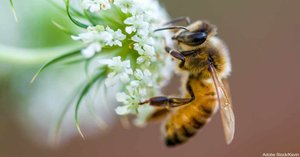While breast cancer is often a very treatable and survivable disease, there are certain subtypes of this type of cancer that more aggressive and have fewer treatment options. These types of breast cancer tend to be more dangerous and difficult to go through.However, a new study has found a potential treatment option for people with certain types of aggressive breast cancer, including triple-negative breast cancer. And the new treatment comes from a surprising natural source. Photo: Adobe Stock/DariosDr. Ciara Duffy, from the Harry Perkins Institute of Medical Research and the University of Western Australia, conducted the research as part of her Ph.D. and published it in the journal npj Precision Oncology. She utilized venom from 312 honeybees and bumblebees from Western Australia, Ireland, and England to see if they would have any effect on certain clinical subtypes of breast cancer.
Photo: Adobe Stock/DariosDr. Ciara Duffy, from the Harry Perkins Institute of Medical Research and the University of Western Australia, conducted the research as part of her Ph.D. and published it in the journal npj Precision Oncology. She utilized venom from 312 honeybees and bumblebees from Western Australia, Ireland, and England to see if they would have any effect on certain clinical subtypes of breast cancer. Photo: Adobe Stock/KevinDr. Duffy humanely collected the bees, putting them to sleep using carbon dioxide and freezing them before removing their venom barbs for careful dissection. She then compared the different types of venom and their effects on cancer cells.The bumblebee venom proved incapable of killing cancer cells. However, the honeybee venom, particularly a component compound it contains called melittin, rapidly destroyed both triple-negative breast cancer cells and HER2-enriched breast cancer cells, regardless of what area of the world the bees were from.
Photo: Adobe Stock/KevinDr. Duffy humanely collected the bees, putting them to sleep using carbon dioxide and freezing them before removing their venom barbs for careful dissection. She then compared the different types of venom and their effects on cancer cells.The bumblebee venom proved incapable of killing cancer cells. However, the honeybee venom, particularly a component compound it contains called melittin, rapidly destroyed both triple-negative breast cancer cells and HER2-enriched breast cancer cells, regardless of what area of the world the bees were from. Photo: Adobe Stock/mirkograul“No-one had previously compared the effects of honeybee venom or melittin across all of the different subtypes of breast cancer and normal cells,” says Dr. Duffy. “We tested honeybee venom on normal breast cells and cells from the clinical subtypes of breast cancer: hormone receptor-positive, HER2-enriched, and triple-negative breast cancer.”Happily, the melittin in the venom can be reproduced synthetically in the lab, meaning that if future tests continue to show that it is effective in treating breast cancer, honeybees and bumblebees will not have to be harvested to create the medication.“The synthetic product mirrored the majority of the anti-cancer effects of honeybee venom,” says Dr. Duffy. “We found that melittin can completely destroy cancer cell membranes within 60 minutes.”
Photo: Adobe Stock/mirkograul“No-one had previously compared the effects of honeybee venom or melittin across all of the different subtypes of breast cancer and normal cells,” says Dr. Duffy. “We tested honeybee venom on normal breast cells and cells from the clinical subtypes of breast cancer: hormone receptor-positive, HER2-enriched, and triple-negative breast cancer.”Happily, the melittin in the venom can be reproduced synthetically in the lab, meaning that if future tests continue to show that it is effective in treating breast cancer, honeybees and bumblebees will not have to be harvested to create the medication.“The synthetic product mirrored the majority of the anti-cancer effects of honeybee venom,” says Dr. Duffy. “We found that melittin can completely destroy cancer cell membranes within 60 minutes.” Photo: Adobe Stock/sergo321So far, it appears that the honeybee venom is “extremely potent” but that a specific concentration of it can result in 100 percent cancer cell death while minimally affecting other healthy cells.Aside from its ability to kill cancer cells, melittin also had another surprising effect. Within 20 minutes, it mitigated the chemical messages that cancer cells use to grow and divide.“We looked at how honeybee venom and melittin affect the cancer signaling pathways, the chemical messages that are fundamental for cancer cell growth and reproduction, and we found that very quickly these signaling pathways were shut down,” says Dr. Duffy. “Melittin modulated the signaling in breast cancer cells by suppressing the activation of the receptor that is commonly overexpressed in triple-negative breast cancer, the epidermal growth factor receptor, and it suppressed the activation of HER2 which is over-expressed in HER2-enriched breast cancer.”
Photo: Adobe Stock/sergo321So far, it appears that the honeybee venom is “extremely potent” but that a specific concentration of it can result in 100 percent cancer cell death while minimally affecting other healthy cells.Aside from its ability to kill cancer cells, melittin also had another surprising effect. Within 20 minutes, it mitigated the chemical messages that cancer cells use to grow and divide.“We looked at how honeybee venom and melittin affect the cancer signaling pathways, the chemical messages that are fundamental for cancer cell growth and reproduction, and we found that very quickly these signaling pathways were shut down,” says Dr. Duffy. “Melittin modulated the signaling in breast cancer cells by suppressing the activation of the receptor that is commonly overexpressed in triple-negative breast cancer, the epidermal growth factor receptor, and it suppressed the activation of HER2 which is over-expressed in HER2-enriched breast cancer.” Photo: Adobe Stock/IoaBalDr. Duffy also tested to see whether melittin could be combined effectively with existing breast cancer treatments. She hypothesized that when the melittin creates holes in cancer cell membranes, other medications might have easier access to their targets.And she was right. Small molecules and chemotherapies, such as docetaxel, were better able to enter the cell and kill it with the help of the melittin treatment. “The combination of melittin and docetaxel was extremely efficient in reducing tumour growth in mice,” she says.More research will be required in the future to determine optimal and maximum tolerated doses, as well as the best mode of delivery for the drug. But so far, this treatment sounds incredibly promising. It’s just one more reason why honeybees are so incredible and so worth protecting! Share on FacebookSource
Photo: Adobe Stock/IoaBalDr. Duffy also tested to see whether melittin could be combined effectively with existing breast cancer treatments. She hypothesized that when the melittin creates holes in cancer cell membranes, other medications might have easier access to their targets.And she was right. Small molecules and chemotherapies, such as docetaxel, were better able to enter the cell and kill it with the help of the melittin treatment. “The combination of melittin and docetaxel was extremely efficient in reducing tumour growth in mice,” she says.More research will be required in the future to determine optimal and maximum tolerated doses, as well as the best mode of delivery for the drug. But so far, this treatment sounds incredibly promising. It’s just one more reason why honeybees are so incredible and so worth protecting! Share on FacebookSource






